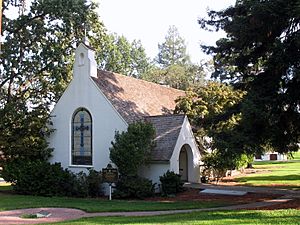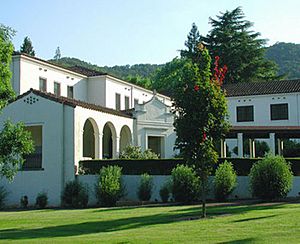Veterans Home of California Yountville facts for kids
The Veterans Home of California in Yountville, California, is a special place that opened in 1884. It's the biggest home of its kind in the United States, helping almost 800 older and disabled veterans. These veterans served in important conflicts like World War II, the Korean War, the Vietnam War, and more recent ones like the War in Afghanistan. The home offers different types of care, from helping veterans live independently to providing skilled nursing care and even an outpatient clinic for medical needs.
The home has many great facilities for the veterans. There's a large theater called the Lincoln Theater, a 9-hole golf course, a baseball field, and a swimming pool. They also have their own U.S. Post Office and a military store. All these are free for the veterans living there. Plus, there's a fitness center, a TV station run by residents, a bowling alley, and a huge library with 35,000 books! There's also a creative arts center and a chapel for different faiths. A cemetery on the grounds holds the graves of over 5,500 veterans and their spouses, some dating back to the Spanish–American War of 1898.
Contents
How the Home Started
In 1877, a group called the Grand Army of the Republic first tried to get land in San Francisco for a veterans' home, but it wasn't suitable.
A different group, focused on creating a California Veteran's Home, officially began on March 7, 1882. After raising enough money and looking at many locations, they bought 910 acres near Yountville for $17,750 on October 25, 1882. Starting in 1883, the State of California helped by giving $15,000 each year. This money was meant to support 100 veterans. The home welcomed its first residents on April 1, 1884.
The home was managed by an 11-member board. Two members were from the Association of Mexican War Veterans, and nine were from the Grand Army of the Republic, representing Union Civil War Veterans. The California Veteran's Home became an official state institution in 1889. When it first opened, there were only 17 residents. But by the end of 1891, the number had grown to 408 men.
In the years after it started, both the Veterans Home and the Napa Valley faced tough financial times. A private group was formed to help the home. This group got money from both the state of California and the federal government. However, in 1896, Washington decided it could no longer fund a privately run facility and stopped its financial support. The private group had to give the Veterans Home over to the state of California in 1897. The state paid the group $20 and officially changed the name to the Veterans Home of California at Yountville. At that time, the home was worth about $320,000. It had 55 buildings with heating, electricity, running water, and a sewer system. The grounds also had a successful dairy, hog farm, and chicken ranch. It was home to 800 veterans from the Mexican, Civil, and Indian wars.
Early 1900s Changes
Colonel Nelson M. Holderman, a veteran of World War I, became the leader of the home in 1919. He had won the Congressional Medal of Honor, a very brave award. Even though he was a tough soldier, his biggest challenge came from the Civil War veterans at the home and on its board. They didn't want the changes he suggested. To avoid a fight, he left his position in 1921, promising to return.
After some board members passed away, Colonel Holderman came back as the leader in 1926. He stayed until he died in 1953. Many people believe he greatly improved the Veterans Home, and his work can still be seen today. Holderman overcame many challenges during his time. He replaced and fixed many old buildings where veterans lived and worked. He also planted the tall trees from around the world that are now known as Holderman's Grove. A very important achievement was overseeing the building of a 500-bed hospital in 1929, which the home had needed for many years.
Late 1900s Improvements
In the 1970s, the home faced another money problem. Less funding meant the buildings and staff were struggling, and the future of the home was uncertain. State and federal health agencies even threatened to stop certifying the home. The California State Legislature took action. They approved a $100 million plan to fix and update the home. This showed California's strong commitment to its veterans, which had lasted for over 100 years.
The Home Today
Today, the Veterans Home of California at Yountville is home to almost 1,200 veterans. This includes nearly 150 women veterans and about 30 couples. Veterans share their ideas and suggestions through the Veterans' Home Allied Council. This group advises the home's leader. The home's yearly budget is $47 million. Half of this comes from California's general fund. The rest comes from other sources, like federal payments and fees from members.
The Veterans' Home of California Yountville gets a lot of support from people, service clubs, and veterans' groups across the state. Their help makes many of the home's services possible, especially when the state faces money problems. The home is a central place for many service organizations. These include AMVETS, Veterans of Foreign Wars, Disabled American Veterans, and The American Legion. These groups represent thousands of veterans and are very active at the home.
The Home is located in the beautiful Wine Country of northern California. It also serves as an alternate office for the governor's office, sharing this duty with another state facility in Fresno. The Home was the main place where the 2014 documentary film, Of Men and War, was filmed. This movie showed the work of a program that helped veterans who served after 9/11. These veterans were dealing with challenges like PTSD (Post-Traumatic Stress Disorder) and TBIs (Traumatic Brain Injuries) and needed help to return to everyday life.
Important People Connected to the Home
- Elizabeth D'Arcy Kinne (1843-1918) was the national president of the Woman's Relief Corps (WRC). She helped a lot in setting up this important institution.



